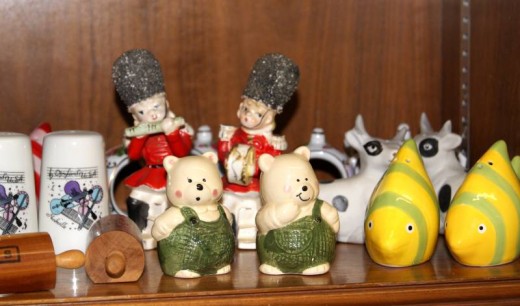Inexpensive Collections for Children
Kids love to collect things. Obviously toy manufacturers know this and profit very well from it. When I was a kid I was a collector, too. Collecting is a great hobby that can be educational as well. Children can learn to save money for additions to their collections, learn the finer points of interpersonal relationships through trading with friends, and the fun of display and sharing their collections with others.
Salt and Pepper Shaker Collection

The first collection I remember started out as gift from a relative. I don't remember which aunt or grandparent gave me the first bed doll, but I loved those small dolls with the pretty dresses. I had these dolls before Barbie made the toy scene. After the first doll I got more as gifts. Sometimes I saved my allowance and bought one. Soon my whole bed was covered with dolls; their dresses spread out in a circle to show off the ruffles and lace. They were in my way at bedtime and making the bed became time-consuming because the dolls had to be arranged just so. That is why I began to hang them on my wall. I must have had a couple of dozen before my interest waned.
I was more the outdoors type and it was a blue jay feather that started my feather collection. I kept them in a box in my toy closet. I spent hour searching the backyard for specimens to add to my collection. Aunt Franny gave me some chicken feathers, and I found seagull feathers at the beach. Then I met Sandy who had her collection mounted, framed, and hanging on her wall. Somehow my collection did not seem up to par after seeing Sandy's museum quality feathers.
I joined 4-H in grade school and my interest in all things outdoors was fired by two projects that required collections. One was a tree identification project in which I collected, and mounted in a scrapbook, leaves from trees in my yard. A pen pal who lived in Florida sent two leaves for my project: one from a palmetto tree and another from an orange tree.
My second 4-H project was entomology. That is the study of insects. I began collecting bugs. I put my specimens in prescription bottles and stored them on shelves in my closet. I carefully researched the bugs in library books to label the bottles and recorded facts about each one. It was a very educational project, and to this day I am not afraid of insects. Mother, on the other hand did not like going into my room, so I had to do all my own cleaning. I earned the title of county champion bug collector two years in a row.
Soon after the feathers I met a new friend who introduced me to stamp collecting. She gave me an order form where I could get a starter kit which included a little album, an envelop of stamps from around the world, and a smaller envelop of stamp hinges. Kay and I met Saturdays to compare notes and show off our new additions. I ordered a new package of stamps with every week's allowance. Relatives began saving their letter envelops for me to carefully steam off the cancelled stamps. My best resources were distant cousins who were missionaries in Kenya. My stamp collecting kept me busy right up until I discovered boys.
Even in my teenage years I collected 45-rpm records, books, and charms for my charm bracelets.
Nature is the best source of collecting for kids because it is free and can be educational. Feathers, bugs, leaves, pressed flowers, rocks, sea shells, and seeds all make good collecting materials. The cost of collecting more expensive items like stamps or coins can be offset by adding them to gift lists. Parents can teach money management by having their children save for their own purchases. Some in-expensive and traditional collections include sports cards, marbles, miniature cars (Matchbox, etc) and postcards.








